《数据库系统概念 Database System Concepts》原书教学资源(第七版,PPT课件讲稿,英文版)Chapter 20 Database System Architectures
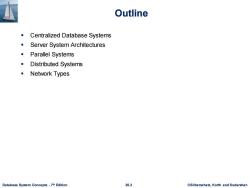
Outline Centralized Database Systems Server System Architectures Parallel Systems ■ Distributed Systems Network Types Database System Concepts-7th Edition 20.2 ©Silberscha乜,Korth and Sudarshan
Database System Concepts - 7 20.2 ©Silberschatz, Korth and Sudarshan th Edition Outline ▪ Centralized Database Systems ▪ Server System Architectures ▪ Parallel Systems ▪ Distributed Systems ▪ Network Types

Centralized Database Systems Run on a single computer system ■Single-user system ·Embedded databases Multi-user systems also known as server systems. Service requests received from client systems Multi-core systems with coarse-grained parallelism Typically a few to tens of processor cores In contrast,fine-grained parallelism uses very large number of computers Database System Concepts-7th Edition 20.3 @Silberschatz,Korth and Sudarshan
Database System Concepts - 7 20.3 ©Silberschatz, Korth and Sudarshan th Edition Centralized Database Systems ▪ Run on a single computer system ▪ Single-user system • Embedded databases ▪ Multi-user systems also known as server systems. • Service requests received from client systems • Multi-core systems with coarse-grained parallelism ▪ Typically a few to tens of processor cores ▪ In contrast, fine-grained parallelism uses very large number of computers
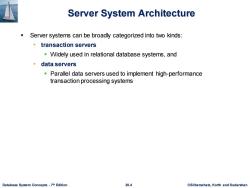
Server System Architecture Server systems can be broadly categorized into two kinds: ·transaction servers Widely used in relational database systems,and ·data servers Parallel data servers used to implement high-performance transaction processing systems Database System Concepts-7th Edition 20.4 ©Silberscha乜,Korth and Sudarshan
Database System Concepts - 7 20.4 ©Silberschatz, Korth and Sudarshan th Edition Server System Architecture ▪ Server systems can be broadly categorized into two kinds: • transaction servers ▪ Widely used in relational database systems, and • data servers ▪ Parallel data servers used to implement high-performance transaction processing systems
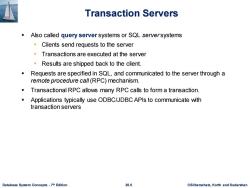
Transaction Servers Also called query server systems or SQL serversystems Clients send requests to the server Transactions are executed at the server Results are shipped back to the client. Requests are specified in SQL,and communicated to the server through a remote procedure call(RPC)mechanism. Transactional RPC allows many RPC calls to form a transaction. Applications typically use ODBC/JDBC APIs to communicate with transaction servers Database System Concepts-7th Edition 20.5 ©Silberscha乜,Korth and Sudarshan
Database System Concepts - 7 20.5 ©Silberschatz, Korth and Sudarshan th Edition Transaction Servers ▪ Also called query server systems or SQL server systems • Clients send requests to the server • Transactions are executed at the server • Results are shipped back to the client. ▪ Requests are specified in SQL, and communicated to the server through a remote procedure call (RPC) mechanism. ▪ Transactional RPC allows many RPC calls to form a transaction. ▪ Applications typically use ODBC/JDBC APIs to communicate with transaction servers
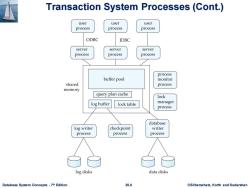
Transaction System Processes(Cont.) user user user process process process ODBC JDBC server server server process process process process buffer pool monitor shared process memory query plan cache lock log buffer lock table manager process database log writer checkpoint writer process process process log disks data disks Database System Concepts-7th Edition 20.6 @Silberschatz,Korth and Sudarshan
Database System Concepts - 7 20.6 ©Silberschatz, Korth and Sudarshan th Edition Transaction System Processes (Cont.)
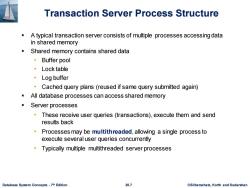
Transaction Server Process Structure A typical transaction server consists of multiple processes accessing data in shared memory Shared memory contains shared data ·Buffer pool ·Lock table ·Log buffer Cached query plans (reused if same query submitted again) All database processes can access shared memory ■Server processes These receive user queries (transactions),execute them and send results back Processes may be multithreaded,allowing a single process to execute several user queries concurrently Typically multiple multithreaded server processes Database System Concepts-7th Edition 20.7 ©Silberscha乜,Korth and Sudarshan
Database System Concepts - 7 20.7 ©Silberschatz, Korth and Sudarshan th Edition Transaction Server Process Structure ▪ A typical transaction server consists of multiple processes accessing data in shared memory ▪ Shared memory contains shared data • Buffer pool • Lock table • Log buffer • Cached query plans (reused if same query submitted again) ▪ All database processes can access shared memory ▪ Server processes • These receive user queries (transactions), execute them and send results back • Processes may be multithreaded, allowing a single process to execute several user queries concurrently • Typically multiple multithreaded server processes

Transaction Server Processes (Cont.) Database writer process Output modified buffer blocks to disks continually Log writer process Server processes simply add log records to log record buffer Log writer process outputs log records to stable storage. ■Checkpoint process .Performs periodic checkpoints Process monitor process Monitors other processes,and takes recovery actions if any of the other processes fail E.g.aborting any transactions being executed by a server process and restarting it Database System Concepts-7th Edition 20.8 ©Silberscha乜,Korth and Sudarshan
Database System Concepts - 7 20.8 ©Silberschatz, Korth and Sudarshan th Edition Transaction Server Processes (Cont.) ▪ Database writer process • Output modified buffer blocks to disks continually ▪ Log writer process • Server processes simply add log records to log record buffer • Log writer process outputs log records to stable storage. ▪ Checkpoint process • Performs periodic checkpoints ▪ Process monitor process • Monitors other processes, and takes recovery actions if any of the other processes fail ▪ E.g. aborting any transactions being executed by a server process and restarting it

Transaction System Processes (Cont.) Lock manager process To avoid overhead of interprocess communication for lock request/grant,each database process operates directly on the lock table instead of sending requests to lock manager process Lock manager process still used for deadlock detection To ensure that no two processes are accessing the same data structure at the same time,databases systems implement mutual exclusion using either ·Atomic instructions Test-And-Set Compare-And-Swap(CAS) Operating system semaphores Higher overhead than atomic instructions Database System Concepts-7th Edition 20.9 ©Silberscha乜,Korth and Sudarshan
Database System Concepts - 7 20.9 ©Silberschatz, Korth and Sudarshan th Edition Transaction System Processes (Cont.) ▪ Lock manager process • To avoid overhead of interprocess communication for lock request/grant, each database process operates directly on the lock table ▪ instead of sending requests to lock manager process • Lock manager process still used for deadlock detection ▪ To ensure that no two processes are accessing the same data structure at the same time, databases systems implement mutual exclusion using either • Atomic instructions ▪ Test-And-Set ▪ Compare-And-Swap (CAS) • Operating system semaphores ▪ Higher overhead than atomic instructions

Atomic Instructions ■Test-And-SetM) Memory location M,initially 0 Test-and-set(M)sets M to 1,and returns old value of M Return value 0 indicates process has acquired the mutex Return value 1 indicates someone is already holding the mutex ·Must try again later Release of mutex done by setting M=0 Compare-and-swap(M,V1,V2) Atomically do following If M=V1,set M=V2 and return success Else return failure With M=0 initially,CAS(M,0,1)equivalent to test-and-set(M) Can use CAS(M,0,id)where id thread-id or process-id to record who has the mutex Database System Concepts-7th Edition 20.10 ©Silberscha乜,Korth and Sudarshan
Database System Concepts - 7 20.10 ©Silberschatz, Korth and Sudarshan th Edition Atomic Instructions ▪ Test-And-Set(M) • Memory location M, initially 0 • Test-and-set(M) sets M to 1, and returns old value of M ▪ Return value 0 indicates process has acquired the mutex ▪ Return value 1 indicates someone is already holding the mutex • Must try again later ▪ Release of mutex done by setting M = 0 ▪ Compare-and-swap(M, V1, V2) • Atomically do following ▪ If M = V1, set M = V2 and return success ▪ Else return failure • With M = 0 initially, CAS(M, 0, 1) equivalent to test-and-set(M) • Can use CAS(M, 0, id) where id = thread-id or process-id to record who has the mutex
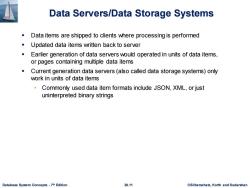
Data Servers/Data Storage Systems m Data items are shipped to clients where processing is performed Updated data items written back to server Earlier generation of data servers would operated in units of data items, or pages containing multiple data items a Current generation data servers(also called data storage systems)only work in units of data items Commonly used data item formats include JSON,XML,or just uninterpreted binary strings Database System Concepts-7th Edition 20.11 ©Silberscha乜,Korth and Sudarshan
Database System Concepts - 7 20.11 ©Silberschatz, Korth and Sudarshan th Edition Data Servers/Data Storage Systems ▪ Data items are shipped to clients where processing is performed ▪ Updated data items written back to server ▪ Earlier generation of data servers would operated in units of data items, or pages containing multiple data items ▪ Current generation data servers (also called data storage systems) only work in units of data items • Commonly used data item formats include JSON, XML, or just uninterpreted binary strings
按次数下载不扣除下载券;
注册用户24小时内重复下载只扣除一次;
顺序:VIP每日次数-->可用次数-->下载券;
- 《数据库系统概念 Database System Concepts》原书教学资源(第七版,PPT课件讲稿,英文版)Chapter 02 Intro to Relational Model.pptx
- 《数据库系统概念 Database System Concepts》原书教学资源(第七版,PPT课件讲稿,英文版)Chapter 19 Recovery System.pptx
- 《数据库系统概念 Database System Concepts》原书教学资源(第七版,PPT课件讲稿,英文版)Chapter 18 Concurrency Control.pptx
- 《数据库系统概念 Database System Concepts》原书教学资源(第七版,PPT课件讲稿,英文版)Chapter 17 Transactions.pptx
- 《数据库系统概念 Database System Concepts》原书教学资源(第七版,PPT课件讲稿,英文版)Chapter 16 Query Optimization.pptx
- 《数据库系统概念 Database System Concepts》原书教学资源(第七版,PPT课件讲稿,英文版)Chapter 15 Query Processing.pptx
- 《数据库系统概念 Database System Concepts》原书教学资源(第七版,PPT课件讲稿,英文版)Chapter 14 Indexing.pptx
- 《数据库系统概念 Database System Concepts》原书教学资源(第七版,PPT课件讲稿,英文版)Chapter 13 Data Storage Structures.pptx
- 《数据库系统概念 Database System Concepts》原书教学资源(第七版,PPT课件讲稿,英文版)Chapter 12 Physical Storage Systems.pptx
- 《数据库系统概念 Database System Concepts》原书教学资源(第七版,PPT课件讲稿,英文版)Chapter 11 Data Analytics.pptx
- 《数据库系统概念 Database System Concepts》原书教学资源(第七版,PPT课件讲稿,英文版)Chapter 10 Big Data.pptx
- 《数据库系统概念 Database System Concepts》原书教学资源(第七版,PPT课件讲稿,英文版)Chapter 01 Introduction(Avi Silberschatz Henry F. Korth S. Sudarshan).pptx
- 《数据库系统概念 Database System Concepts》原书教学资源(第五版,PPT课件讲稿,英文版)Chapter 9 Object-Based Databases.ppt
- 《数据库系统概念 Database System Concepts》原书教学资源(第五版,PPT课件讲稿,英文版)Chapter 8 Application Design and Development.ppt
- 《数据库系统概念 Database System Concepts》原书教学资源(第五版,PPT课件讲稿,英文版)Chapter 7 Relational Database Design.ppt
- 《数据库系统概念 Database System Concepts》原书教学资源(第五版,PPT课件讲稿,英文版)Chapter 6 Entity-Relationship Model.ppt
- 《数据库系统概念 Database System Concepts》原书教学资源(第五版,PPT课件讲稿,英文版)Chapter 5 Other Relational Languages.ppt
- 《数据库系统概念 Database System Concepts》原书教学资源(第五版,PPT课件讲稿,英文版)Chapter 4 Advanced SQL.ppt
- 《数据库系统概念 Database System Concepts》原书教学资源(第五版,PPT课件讲稿,英文版)Chapter 3 SQL.ppt
- 《数据库系统概念 Database System Concepts》原书教学资源(第五版,PPT课件讲稿,英文版)Chapter Advanced Transaction Processing.ppt
- 《数据库系统概念 Database System Concepts》原书教学资源(第七版,PPT课件讲稿,英文版)Chapter 21 Parallel and Distributed Storage.pptx
- 《数据库系统概念 Database System Concepts》原书教学资源(第七版,PPT课件讲稿,英文版)Chapter 22 Parallel and Distributed Query Processing.pptx
- 《数据库系统概念 Database System Concepts》原书教学资源(第七版,PPT课件讲稿,英文版)Chapter 23 Parallel and Distributed Transaction Processing.pptx
- 《数据库系统概念 Database System Concepts》原书教学资源(第七版,PPT课件讲稿,英文版)Chapter 24 Advanced Indexing.pptx
- 《数据库系统概念 Database System Concepts》原书教学资源(第七版,PPT课件讲稿,英文版)Chapter 25 Advanced Application Development.pptx
- 《数据库系统概念 Database System Concepts》原书教学资源(第七版,PPT课件讲稿,英文版)Chapter 26 Blockchain Databases.pptx
- 《数据库系统概念 Database System Concepts》原书教学资源(第七版,PPT课件讲稿,英文版)Chapter 27 Formal-Relational Query Languages.pptx
- 《数据库系统概念 Database System Concepts》原书教学资源(第七版,PPT课件讲稿,英文版)Chapter 28 Advanced Relational Database Design.pptx
- 《数据库系统概念 Database System Concepts》原书教学资源(第七版,PPT课件讲稿,英文版)Chapter 29 Object-Based Databases.pptx
- 《数据库系统概念 Database System Concepts》原书教学资源(第七版,PPT课件讲稿,英文版)Chapter 03 Introduction to SQL.pptx
- 《数据库系统概念 Database System Concepts》原书教学资源(第七版,PPT课件讲稿,英文版)Chapter 30 XML.pptx
- 《数据库系统概念 Database System Concepts》原书教学资源(第七版,PPT课件讲稿,英文版)Chapter 31 Information Retrieval.pptx
- 《数据库系统概念 Database System Concepts》原书教学资源(第七版,PPT课件讲稿,英文版)Chapter 04 Intermediate SQL.pptx
- 《数据库系统概念 Database System Concepts》原书教学资源(第七版,PPT课件讲稿,英文版)Chapter 05 Advanced SQL.pptx
- 《数据库系统概念 Database System Concepts》原书教学资源(第七版,PPT课件讲稿,英文版)Chapter 06 Database Design Using the E-R Model.pptx
- 《数据库系统概念 Database System Concepts》原书教学资源(第七版,PPT课件讲稿,英文版)Chapter 07 Normalization.pptx
- 《数据库系统概念 Database System Concepts》原书教学资源(第七版,PPT课件讲稿,英文版)Chapter 08 Complex Data Types.pptx
- 《数据库系统概念 Database System Concepts》原书教学资源(第七版,PPT课件讲稿,英文版)Chapter 09 Application Development.pptx
- 计算机科学与技术教学资源(参考文献)The generalized Cholesky factorization method for saddle point problems.pdf
- 计算机科学与技术教学资源(参考文献)Inverse updating and downdating for weighted linear least squares using M-invariant reflections.pdf
